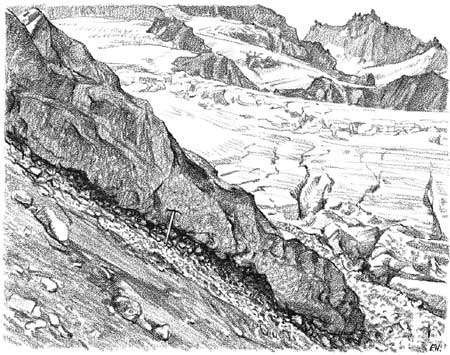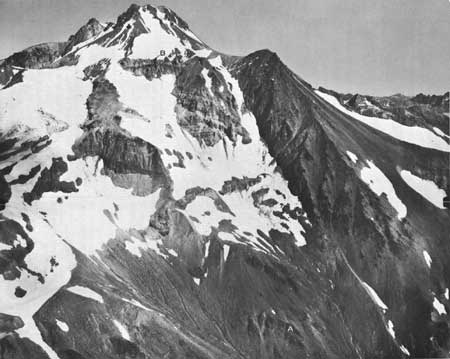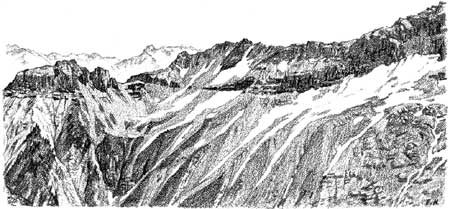
|
Geological Survey Professional Paper 604
On Batholiths and Volcanoes—Intrusion and Eruption of Late Cenozoic Magmas in the Glacier Peak Area, North Cascades, Washington |
LATE EPISODE OF VOLCANISM: GLACIER PEAK VOLCANO AND ASSOCIATED ROCKS
PREVIOUS WORK
Glacier Peak received little attention from geologists between the first ascent and exploratory reconnaissance at the end of the 19th century by I. C. Russell (1900, p. 134-135), who reported the mountain to be a cinder cone, and the geologic study in the fifties by A. B. Ford (1959, p. 250-331), who determined the basic history of the volcano and recognized it as a considerably eroded lava cone flanked by huge fans of volcaniclastic debris.
GENERAL FEATURES OF THE VOLCANO
Glacier Peak volcano rises magnificently above its basement of metamorphic rocks (frontispiece), and its dark-colored lava flows contrast strikingly with the lighter hues of the schist and gneiss. The volcano began to grow in a mountainous landscape considerably different from today's and continued growing into more recent time; hence its flows represent a variety of eroded forms, ranging from young, barely dissected flows in present valley bottoms to remnants of older flows carved into spurs and isolated ridge caps.
The aggregate thickness of the Glacier Peak lava flows nowhere exceeds 2,500 feet. The cone is perched on a high bedrock ridge. This is barely a third the thickness of flows standing as Mount Rainier (Fiske and others, 1963, pl. 1). The individual flows on Glacier Peak vary greatly in thickness. Columnar joints predominate in the thick flows, whereas platy or blocky joints are common in thin flows, especially those around the summit.
The predominant rock of Glacier Peak is pyroxene dacite. The dacites are dark gray to black, especially those which occur in thick flows that now cap ridges. Flows making up the summit area of the cone are commonly oxidized red or are gray with red splotches.
Little pyroclastic material is interbedded with the flows; this is somewhat surprising considering that the latest eruption(s) were predominantly pyroclastic. The most common interbeds between lava flows are coarse breccias which resemble the erosional debris and moraine that blanket many slopes of the volcano today. Such interflow breccias are best exposed along Kennedy Creek and southeast of Cool Glacier. Breccias are usually best exposed at the base of flows, and many are somewhat agglutinated, which suggests that they were derived from and overridden by the advancing front of the overlying flow. Some volcanic breccias and conglomerates which lie on the nonvolcanic basement rocks are rich in granitic and metamorphic debris and are overlain by lava. The volcano probably has been mantled by glaciers ever since it emerged, so that much of the breccia is certainly moraine. One graphic example of an interflow moraine crops out near the toe of the Kennedy Glacier (fig. 27).

|
| FIGURE 27.—Moraine underlying dacite flow of Glacier Peak on north side of Kennedy Glacier. More recent moraine lies immediately adjacent to the ice. Ice ax for scale. Sketched from a photograph by Ed Hanson. |
THE CRATER
The crater, first recognized by Ford (1959, p. 313), lies just north of the summit; it is obscured by erosion and filled with snow and ice. The ice flows eastward out of the crater as the Chocolate Glacier (fig. 43). A considerable breach on the west rim of the crater forms the pass at the head of the Scimitar Glacier. Locally, the rocks on the north rim of the crater are highly oxidized, and some are stained a blotchy yellow, which suggests solfataric activity. The narrow pass between the north rim of the crater and the pinnacles of eroded lava known as the Rabbit Ears is also highly stained and brecciated.
DISAPPOINTMENT PEAK FLOW
On the south side of the main cone, Disappointment Peak (alt. 8,755 feet) interrupts the otherwise smooth declivity of the south slope. It is underlain by a single large and thick dacite flow (fig. 28). The hypersthene dacite flow of Disappointment Peak is uniform in appearance except for color, which ranges from light gray through hues of pink to deep red; joints break it into irregular blocks of varying size. Conspicuous red-black prisms of oxyhornblende and a higher vesicularity distinguish the Disappointment Peak dacite from most of the other dacites of Glacier Peak.

|
| FIGURE 28.—Southwest side of Glacier Peak, view showing thin flows of the summit cone truncated by dark-colored dacite of the Disappointment Peak dome. Outcrops at lower right (A) are basement schists. Possible dike (B) visible against snow at base of summit snowfield. Photograph by Austion Post. |
We found no flow lines in the lava of Disappointment Peak, but its uniform lithology suggests the peak is a dome that oozed down the side of the main cone. Its highly irregular jointing and its composition, characteristic of hornblende dacite domes of Lassen (Williams, 1932, p. 316; 1942, p. 155) and other Cascade volcanoes, support this contention.
On the west side of Glacier Peak, the contact between the Disappointment Peak dome and Glacier Peak flows trends directly upslope, and the dome appears to overlie and truncate the flows (fig. 28). The lowest outcrop of the Disappointment Peak dome is at 7,200 feet, 400 feet below the highest exposures of bedrock on the southwest side of the cone and well below projections of the bedrock surface from beneath the cone (see p. 59). If the lava of Disappointment Peak dome were older than most of the summit cone lavas, it could not have flowed to such a low altitude, for presumably the entire erosional level was higher prior to formation and degradation of the cone. Hence, the dome is probably younger than most of the Glacier Peak lava flows.
STRATIGRAPHY OF THE LAVAS
"The scoffers said it couldn't be done,
The odds were so great who wouldn't.
But we tackled the job that couldn't be done,
And what do you think? It couldn't!"—Anonymous
The lavas of the northernmost Cascade volcanoes have been described by several generations of workers as monotonous in lithology, mineralogy, and chemistry. Indeed, we have found no sure criteria by which the lavas of Glacier Peak can be distinguished from one another, nor could we determine a stratigraphic sequence which could be integrated over the entire volcano. Marker beds of pyroclastics are conspicuously lacking, and attempts at correlation on a lithologic basis have failed, except locally. It has been necessary to rely largely on physiography and certain assumptions set forth below to achieve the tentative sequence depicted on the map. A concise description of these same principles has been presented by Fiske, Hopson, and Waters (1963, p. 68).
The oldest flows are those that cap ridgetops or form ridges (fig. 29). Some of these are 100 to 400 feet thick; such a thickness indicates that they must have ponded in flat-floored valleys. Several of these flows have been isolated by erosion from the peak itself and the valleys beside them have been deeply carved by glaciers. The best example of the oldest is the flow(s?) forming Vista Ridge.

|
| FIGURE 29.—Ridge-capping flow of Gamma Ridge at end of ridge (left) unconformably overlain by younger Glacier Peak ridge-capping flows (middle and right). View looking northeast across head of Milk Creek. Glaciated outcrops of bedrock gneiss below Ptarmigan Glacier on right, altered dacite intrusive breccia on left. Sketched by Ed Hanson from a photograph. |
The next oldest flows are those that cling to the sides of present valleys but have been considerably dissected by modern streams and perhaps by Pleistocene glaciers as well. Their bottom contacts lie close to the present drainage level, and their upper surfaces still show some of their original flow form.
Clearly the youngest flows are those that bottom present-day stream valleys and, in general, show little dissection. Ford (1959, p. 321) thought that the Vista Creek flow overlies uneroded moraines in the Vista Creek valley. The flow in the bottom of Vista Creek is the best example; but others included in this age group are flows in Kennedy Creek—more highly eroded than the flow in Vista Creek—and flows interbedded in the stratified fill in the Suiattle valley, a deposit laid down in a Pleistocene Valley.
The timespan for any one of these age categories may be great, and assignment of a particular flow to a particular age is commonly questionable. The distinction between valley-clinging and valley-bottom flows is especially difficult to make.
Flows making up the cone may be younger than all the ridge-capping flows except for the very thick and subhorizontal flows that rest on Gamma Ridge volcanic rocks and form a striking cleaver at the head of Dusty Creek (see fig. 21). The risks of assigning other flows of the summit cone to the age categories outlined above are obvious, and we have treated them as undifferentiated.
The Disappointment Peak dome apparently truncates many of the thin flows of the summit cone and may be one of the youngest eruptive features, yet there is no sure way to place the dome in the sequence of age groups. Its age lies between that of the valley-clinging flows and final pumice eruptions. There are a few (young?) flows of similar lithology scattered about the summit cone.
The stratified fill of the Suiattle River valley is clearly the result of a recent event. Its age and origin are discussed in detail in a later section, but the conclusions can be stated here: It is roughly of the same age as the Disappointment Peak dome and the valley-bottom flows, but older than the overlying blanket of pumice lapilli and the fill of the White Chuck River valley, which contains these lapilli.
AGE OF THE VOLCANO
There are little data on the age of Glacier Peak. Of great interest would be studies of datable Pleistocene and Recent deposits west of the volcano that may be interbedded with its debris. These studies have not been made except in a limited way by Vance (1957, p. 292-294). We can, however, bracket the age of Glacier Peak between 700,000 and 12,000 years B.P. (before present). The maximum age was determined by measuring, with a flux-gate magnetometer, the polarity of two oriented specimens from each of five flows that range from the oldest recognized ridge-capping flow to the Disappointment Peak dome. We did not check for viscous magnetization, which in special circumstances can mask reversed polarization (Cox and Doell, 1960, p. 650). All specimens but one have normal polarity, and the magnetic poles of this one are so scattered that we suspect it was struck by lightning—an event that produces anomalous magnetization (Cox, 1961). The Matuyama reversed polarity epoch extends from 0.7 to 2.5 m.y. B.P. and includes one very short normal event (the Jaramillo) at about 0.9 m.y. B.P. (Cox and Doell, 1960, p. 650; Doell and Dalrymple, 1966, p. 1061). If activity of Glacier Peak began before the reversed epoch (before 2.5. m.y. B.P.) and extended to recent postglacial time, some flows should show reverse polarization, but they do not. Thus all the flows were probably extruded during the present period of normal polarization, that is, within the past 700,000 years. Our sampling might have missed the short reversal prior to the Jaramillo event; if so, the age could be extended to about 900,000 years. The minimum age of 12,000 years is a carbon-14 date on shells occurring with pellets of the youngest Glacier Peak pumice in lake deposits of eastern Washington (Fryxell, 1965; see also p. 41).
Some flows are older than 15,000 to 13,500 years, which is indicated by the work of Vance (1957, p. 292), who found till containing Glacier Peak dacite fragments underlying lake deposits. The lake formed in the White Chuck valley because it was dammed by an ice lobe (Vance, 1957) which last occupied the Puget Sound area between 15,000 and 13,500 years ago (Rigg and Gould, 1957, p. 357-358; Crandell and others, 1965, p. B134). The oldest flows, that is, the ridge-capping flows and the valley-clinging flows, were erupted before the main valleys were last glaciated, as was recognized by Ford (1959, p. 321). The last major advance of Cascade glaciers took place 18,000 to 21,000 years ago (Armstrong and others, 1965, p. 324); hence, the first eruptions of Glacier Peak began prior to about 18,000 years B.P. Carithers (1946, p. 31) did not recognize the older flows and stated that the cone of the volcano was built "since Pleistocene time."
The flows lying in glaciated valleys were erupted after the last major glacial advance in the Cascades in late Pleistocene time, 17,000 to 21,000 B.P., but before the pumice eruption at 12,000 years B.P. The deposition of the stratified fill in the glaciated Suiattle valley apparently took place in this same interval. Glaciers may well have occupied valleys near the high-standing volcano longer than in most other places; thus, flows in these nearby valleys may be considerably younger than 17,000 years.
There is no evidence of eruptions of Glacier Peak more recent than 12,000 years B.P. The only indication of lingering heat are three hot springs at the base of the cone.
| <<< Previous | <<< Contents >>> | Next >>> |
/pp/604/sec3.htm
Last Updated: 28-Mar-2006